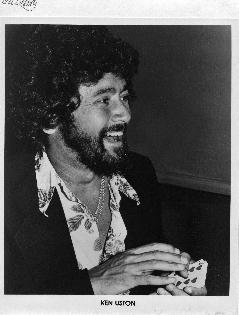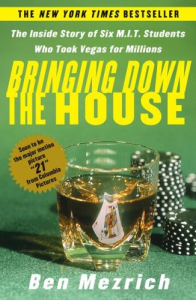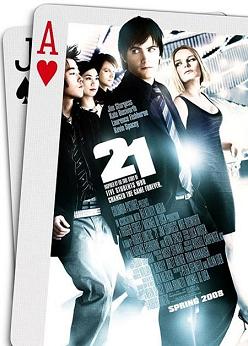Related Research Articles

Games available in most casinos are commonly called casino games. In a casino game, the players gamble cash or casino chips on various possible random outcomes or combinations of outcomes. Casino games are also available in online casinos, where permitted by law. Casino games can also be played outside of casinos for entertainment purposes, like in parties or in school competitions, on machines that simulate gambling.

Roulette is a casino game which was likely developed from the Italian game Biribi. In the game, a player may choose to place a bet on a single number, various groupings of numbers, the color red or black, whether the number is odd or even, or if the numbers are high (19–36) or low (1–18).

Card counting is a blackjack strategy used to determine whether the player or the dealer has an advantage on the next hand.
Online casinos, also known as virtual casinos or Internet casinos, are online versions of traditional casinos. Online casinos enable gamblers to play and wager on casino games through the Internet. It is a prolific form of online gambling.
The MIT Blackjack Team was a group of students and ex-students. The students were from Massachusetts Institute of Technology, Harvard University, and other leading colleges; they used card counting techniques and more sophisticated strategies to beat casinos at blackjack worldwide. The team and its successors operated successfully from 1979 through the beginning of the 21st century. Many other blackjack teams around the world have been formed with the goal of beating the casinos.
Cheating in casinos refers to actions by the player or the house which are prohibited by regional gambling control authorities. This may involve using suspect apparatus, interfering with apparatus, chip fraud or misrepresenting games. The formally prescribed sanctions for cheating depend on the circumstances and gravity of the cheating and the jurisdiction in which the casino operates. In Nevada, for a player to cheat in a casino is a felony under Nevada law. In most other jurisdictions, specific statutes do not exist, and alleged instances of cheating are resolved by the gambling authority who may have more or less authority to enforce its verdict.
Ronald Dale Harris is a computer programmer who worked for the Nevada Gaming Control Board in the early 1990s and was responsible for finding flaws and gaffes in software that runs computerized casino games. Harris took advantage of his expertise, reputation and access to source code to illegally modify certain slot machines to pay out large sums of money when a specific sequence and number of coins were inserted. From 1993 to 1995, Harris and an accomplice stole thousands of dollars from Las Vegas casinos, accomplishing one of the most successful and undetected scams in casino history.
Edward Oakley Thorp is an American mathematics professor, author, hedge fund manager, and blackjack researcher. He pioneered the modern applications of probability theory, including the harnessing of very small correlations for reliable financial gain.

Ken Uston was an American blackjack player, strategist and author, credited with popularizing the concept of team play at blackjack. During the early to mid-1970s he gained widespread notoriety for perfecting techniques to do team card counting in numerous casinos worldwide, earning millions of dollars from the casinos, with some bets as high as $12,000 on a single hand.

Bringing Down the House: The Inside Story of Six MIT Students Who Took Vegas for Millions is a 2003 book by Ben Mezrich about a group of MIT card counters commonly known as the MIT Blackjack Team. Though the book is classified as non-fiction, The Boston Globe alleges that the book contains significant fictional elements, that many of the key events propelling the drama did not occur in real life, and that others were exaggerated greatly. The book was adapted into the movies 21 and The Last Casino.
Thomas Hyland is an American professional blackjack player and a 2002 inductee to the Blackjack Hall of Fame. Hyland studied political science at Wittenberg University in Springfield, Ohio. Since 1979, he has been recognized for his role in forming and managing two blackjack teams. Hyland is also a card counting expert.

21 is a 2008 American heist drama film directed by Robert Luketic and distributed by Sony Pictures Releasing. The film is inspired by the story of the MIT Blackjack Team as told in Bringing Down the House, the best-selling 2003 book by Ben Mezrich. IMDb offers a brief summary of the film: "21 is about six MIT students who become trained to be experts in card counting in Black Jack and subsequently took Las Vegas casinos for millions in winnings." The film stars Jim Sturgess, Kevin Spacey, Laurence Fishburne, Kate Bosworth, Liza Lapira, Jacob Pitts, Aaron Yoo, and Kieu Chinh. 21 was a box office success and was the number one film in the United States and Canada during its first and second weekends of release, despite some mixed reviews.
Jerry L. Patterson is an American writer. He authored several gambling books as well as a gambling newspaper column.
Advantage gambling, or advantage play, refers to legal methods used to gain an advantage while gambling, in contrast to cheating. The term usually refers to house-banked casino games, but can also refer to games played against other players, such as poker. Someone who practises advantage gambling is often referred to as an advantage player, or AP. Unlike cheating, which is by definition illegal, advantage play exploits innate characteristics of a particular game to give the player an advantage relative to the house or other players. While not illegal, advantage play is often discouraged and some advantage players may be banned by certain casinos.

Busting Vegas is a 2005 book by Ben Mezrich about a group of MIT card counters and blackjack players commonly known as the MIT Blackjack Team. The subtitle of the original, hardcover edition was The MIT Whiz Kid Who Brought the Casinos to Their Knees, but the subtitle of the subsequent paperback editions was A True Story of Monumental Excess, Sex, Love, Violence, and Beating the Odds.
The Eudaemons were a small group headed by graduate physics students J. Doyne Farmer and Norman Packard at the University of California Santa Cruz in the late 1970s. The group's immediate objective was to find a way to beat roulette using a concealed computer, but a loftier objective was to use the money made from roulette to fund a scientific community. The name of the group was inspired by the eudaimonism philosophy.
"How to Take Down a Casino", also called "How to Beat a Casino" or "How to Beat the Casino", is the fourth and final special in British psychological illusionist Derren Brown's The Events television series. The episode featured both live and pre-recorded segments, and showed Brown attempting to win £175,000 by placing money that he had taken from a member of the public on a roulette wheel in an undisclosed European casino.

Mike Goodman was an American professional gambler, a pit boss for a Las Vegas casino, and an author of books that gave advice on gambling and told stories of gamblers and their escapades. He is most known for his 1963 book How to Win: At Cards, Dice, Races, Roulette, which went through many printings and sold over a million copies.
Four Horsemen of the Apocalypse is the name given by gambling authors to the four U.S. Army engineers who first discovered in the 1950s the best playing strategy in the casino game of Blackjack that can be formulated on the basis of the player's and the dealer's cards. The so-called Basic Strategy, which was subsequently refined through the use of computers and combinatorial analysis, loses the least money to the casino in the long term.

Trump Castle is a series of gambling video games published by Capstone Software between 1989 and 1993. The games are named after Trump's Castle hotel-casino in Atlantic City, New Jersey, and were released for Amiga, Atari ST, Commodore 64, Commodore 128, and MS-DOS.
References
- ↑ "Good bet: riveting glimpse of cheaters in Vegas". The Miami Herald. March 1, 2005. p. 5. Retrieved May 8, 2022.